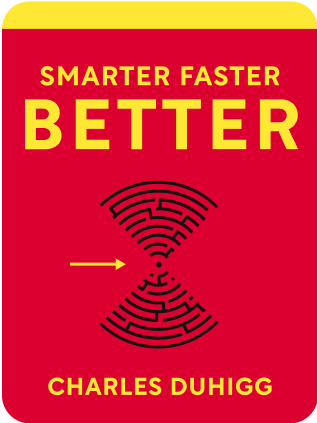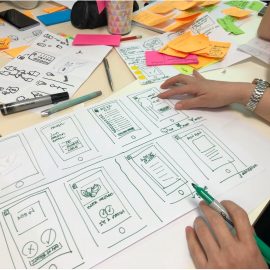

This article is an excerpt from the Shortform book guide to "Smarter Faster Better" by Charles Duhigg. Shortform has the world's best summaries and analyses of books you should be reading.
Like this article? Sign up for a free trial here .
Do you know how to innovate effectively? How can this skill lead to greater productivity and success?
Productive people know how to innovate. In Smarter Faster Better, Charles Duhigg shares four principles that you can implement to create conditions for creativity and productive innovation to thrive.
Read more to learn how to innovate, the Smarter Faster Better way.
Productive People Know How to Innovate
You may not think of yourself as an innovator, but innovation is likely a crucial aspect of your job. If you make your creative process more productive, you’ll increase your overall productivity. But what does it actually mean to be innovative?
An innovator comes up with new and exciting ideas. A productive innovator does this relatively quickly while also maintaining a high standard of work.
To be innovative, you need to be creative. This is a skill that in many ways can’t be taught. After all, creativity is often spontaneous. It’s hard to artificially trigger it by following a prescribed set of instructions.
However, you can learn how to innovate. You can discover how to create the right conditions for creativity and productive innovation to thrive. There are four principles that you can implement to create the conditions to be innovative:
- Combine old ideas in new ways.
- Use your experiences and emotions to validate and generate ideas.
- Embrace frustration and anxiety as a fuel for new ideas.
- Remain open to alternative ideas.
Principle #1: Combine Old Ideas in New Ways
This first principle centers on the fact that innovation doesn’t have to be about creating something totally new. At the same time, simply rehashing somebody else’s idea without putting your own spin on it isn’t particularly productive. Instead, the most productive path forward is often the happy medium between these two approaches: finding new ways to combine tried and trusted concepts.
Combining old ideas rather than creating totally new ones can make you more productive by helping you to innovate faster. Not having to start from scratch will inevitably save you time and energy. At the same time, you’re retaining your innovative spirit: even though you’re starting with someone else’s ideas, the way you’re using them is original and creative.
This is a method of driving innovation that’s seen success in a range of industries and situations. For example, the bicycle helmet was invented when a designer took the durable design of a boat’s hull and made it hat-shaped. Likewise, to create his best-selling baby book The Common Sense Book of Baby and Child Care, Benjamin Spock mixed existing childcare techniques with the psychological theories of Sigmund Freud. He knew how to innovate, and it led to success.
Principle #2: Use Your Experiences and Emotions to Validate and Generate Ideas
While drawing from old ideas can be powerful in speeding up innovation, you need to make sure that these old ideas are actually good. Combining two weak existing ideas in a new way won’t necessarily create a good new idea. For instance, if you’re embarking on a creative project such as a film or a play, you need to make sure that you don’t fall into the trap of combining old clichés.
Clichés don’t usually represent reality. They’re a neat way to tie up a story, but they aren’t authentic, and your audience will know that. So, if you choose to innovate by combining clichés, you’re going to end up with a new concept that doesn’t feel realistic or true. People won’t be able to fully connect to your creation emotionally. For this reason, it probably won’t be successful.
How can you separate strong ideas from clichés? By drawing on your personal experiences and emotions. You should ask yourself whether the concepts you’re using feel clichéd. Does the concept match up with how you’ve experienced the world, and how those experiences made you feel? Does it feel true? Or does the concept feel emotionally hollow, predictable, and unrealistic? Your answers to these questions will tell you whether the concept is authentic enough to pursue, or if it’s a cliché that needs to be abandoned.
Of course, if you choose to abandon your clichéd concepts, you’ll need to find new ideas to replace them. In such situations, you can use your own life experiences and emotions as creative fodder. To take the example of creating a film or play, this may take the form of putting a little bit of yourself into your story – making your characters feel what you’ve felt, or experience what you’ve experienced. By doing this, you ensure your idea is rooted in reality and feels authentic. After all, it’s based on your true experiences.
Example: West Side Story
West Side Story is a wildly successful musical that combines the existing art forms of ballet, opera, and theater to create an entirely new kind of Broadway show. Part of the show’s success is rooted in its innovative nature—a nature that the show’s creator, Jerome Robbins, took great pains to cultivate.
During the show’s planning stages, Robbins was insistent that clichéd and predictable theatre techniques should be avoided. For instance, the play’s opening scene was initially a traditional discussion between characters. Robbins scrapped this. To him, it felt boring and clichéd. Instead, he demanded an opening scene that was ambitious and different from anything that came before.
The result of this demand was the creation of the iconic West Side Story prologue, which expresses the tension between two rival gangs – the Jets and the Sharks – through dance. No words are spoken; instead, movement tells the story.
Robbins understood how to innovate. He encouraged his co-creators to pour their own emotions into the show to increase its authenticity. West Side Story explores themes such as suffering from prejudice, being ambitious, and feeling like an outcast. The show’s creators had all experienced these emotions. Channeling these feelings into their work allowed the creators to add authenticity and emotional resonance to the show.
Principle #3: Embrace Frustration and Anxiety as a Fuel for New Ideas
Anxiety and frustration are generally considered to be negative emotions. However, they can each have a positive impact on the process of innovation. They can push you to make breakthroughs that lead to productive innovation.
Frustration
If you take the time to contemplate areas of your life that are making you feel frustrated, you may identify opportunities for innovation. You can look for creative solutions to your problems that will decrease your frustration and make your life easier. In doing this, you might just come up with the next big idea.
For example, the inventor of the Post-it note was an engineer who became frustrated when his bookmark wouldn’t stay put in his church hymnal. He added an adhesive to the bookmark, thus innovating a solution that eventually evolved into a highly successful product. Likewise, cellophane was invented when a scientist, motivated by frustration, looked for a way to shield his tablecloth from spilled wine.
Anxiety
Struggling to innovate new ideas quickly and effectively can push us into a state of stress and anxiety. This is especially true if there are time pressures involved and we need to innovate a new idea as quickly as possible.
This anxiety can lead to a cognitive state that psychologists refer to as “creative desperation.” When we experience creative desperation, our anxiety drives us to desperately search for new and creative ways of looking at an issue. We might start formulating unusual combinations of old ideas, in the hope that one of these new approaches works. In our desperation, we may stumble upon an innovative idea that we would have otherwise ignored.
Studies have shown that creative desperation plays a large part in generating innovation. For example, research by psychologist Gary Klein suggests that this type of stress is a factor in around 20% of creative breakthroughs.
Principle #4: Remain Open to Alternative Ideas
Once you’ve had a creative breakthrough, the relief can be immense—especially if you were in a heightened state of anxiety beforehand. Unfortunately, this relief can hurt your ability to innovate and ultimately harm your productivity.
Once you’ve finally come up with a good idea, you may become so happy that you’ve reached this point that you become blind to other, even better possibilities. You don’t want to relive the stress that you endured while searching for your innovative idea. Instead, you focus all of your attention on this one idea and refuse to consider alternatives.
This way of thinking is especially problematic if you’re still midway through a large project, and need to continue to innovate to make it to the end. You can end up feeling stuck and unable to move forward. You may go around and around in circles trying to push your existing idea further, rather than contemplating alternative approaches.
There are a number of techniques that you can employ to avoid becoming closed off to new ideas. Firstly, you can maintain an awareness that this type of thinking can set in. If you stay vigilant, you can actively try to avoid falling into this cognitive trap.
Secondly, you should force yourself to re-examine your big ideas, no matter how much you want to avoid doing so. Don’t let the fear of having to restart the creative process stop you from honestly evaluating the success or effectiveness of your innovations.
Thirdly, keep some emotional distance from your ideas. That way, you’re able to look at your innovations objectively and may recognize that there are superior alternative options out there.
Finally, if you’re innovating as part of a team, you can startle yourself and your colleagues out of this kind of innovative rut by disrupting the team dynamics, even by a small amount. For instance, you could switch around people’s roles within the team and give each member new responsibilities. Having a different role forces you to look at the team’s ideas from a new perspective. You may spot possible areas for improvement or alternative approaches that you wouldn’t have noticed in your old role.
Once you know how to innovate, the sky’s the limit.

———End of Preview———
Like what you just read? Read the rest of the world's best book summary and analysis of Charles Duhigg's "Smarter Faster Better" at Shortform .
Here's what you'll find in our full Smarter Faster Better summary :
- Why becoming more productive isn’t about working longer hours or constantly pushing yourself to do more
- The 8 principles for improving productivity
- How to create a work culture in which each employee is truly valued






